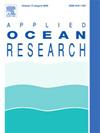匀速水流中自由跨越海底电缆涡流诱发振动的三维数值模拟
IF 4.3
2区 工程技术
Q1 ENGINEERING, OCEAN
引用次数: 0
摘要
自由跨越海底电缆是一种具有一定下垂度的细长柔性结构,与海上立管和海底管道相比,在水流中表现出独特的涡流诱发振动(VIV)特性。为研究海缆的 VIV,建立了基于有限差分法(FDM)和有限元法(FEM)的三维数值模型。在流体动力学模型中,采用大涡流模拟法关闭湍流运动方程;在结构动力学模型中,采用梁元法求解结构运动方程。在固定笛卡尔流体网格中,采用分析映射法重建结构表面,并使用沉浸边界法处理流固界面的边界条件。由于模拟下垂海底电缆的 VIV 需要在电缆表面附近进行大量的局部网格细化,因此开发了一种多 GPU 节点的分区并行算法,以提高计算效率,其中单 GPU 的并行效率可达 80-90%。数值模拟得到的横向响应振幅和频率与实验结果非常吻合。数值模拟分析了实验中未测量到的流向振动响应。结果发现,当缆索的平衡剖面在阻力作用下发生流向偏转时,会产生与横向振动频率相同的流向振动,且流向振动振幅随下垂度的增加而增大。数值模拟提供的详细流场信息表明,涡流结构的大小随速度的增加而逐渐增大,涡流结构的形状与缆索的横向振动模式密切相关。本文章由计算机程序翻译,如有差异,请以英文原文为准。
Three-dimensional numerical simulation of vortex-induced vibration of a free spanning submarine cable in uniform currents
The free spanning submarine cable, a slender and flexible structure with a certain sag, exhibits unique vortex-induced vibration (VIV) characteristics in currents compared to offshore risers and submarine pipelines. To study the VIV of the cable, a three-dimensional numerical model based on the finite difference method (FDM) and the finite element method (FEM) is established. The large eddy simulation method is employed to close the turbulent motion equations in the hydrodynamic model, while the beam element method is used to solve the structural motion equations in the structural dynamic model. An analytical mapping method is adopted for the reconstruction of the structure surface in the fixed Cartesian fluid grids, and the immersed boundary method is used to deal with boundary conditions at fluid-solid interfaces. Since simulating VIV of a submarine cable with sag requires extensive local grid refinement near the cable's surface, a partition parallel algorithm with multi-GPU nodes is developed to enhance the computational efficiency, where the parallel efficiency of a single GPU can reach 80–90%. The numerical model is validated by a laboratory experiment on the VIV of a submarine cable, where the transverse response amplitudes and frequencies obtained by numerical simulation agree well with the experimental results. The streamwise vibration responses that are not measured in the experiment are analyzed by the numerical simulation. It is found that when the cable's equilibrium profile is deflected in the streamwise direction by the drag force, the streamwise vibration with the same frequency as the transverse vibration occurs, and the streamwise vibration amplitude increases with sag. The detailed flow field information provided by numerical simulation indicates that the size of the vortex structures gradually increases with the velocity, and the shape of the vortex structure has a strong correlation with the transverse vibration mode of the cable.
求助全文
通过发布文献求助,成功后即可免费获取论文全文。
去求助
来源期刊

Applied Ocean Research
地学-工程:大洋
CiteScore
8.70
自引率
7.00%
发文量
316
审稿时长
59 days
期刊介绍:
The aim of Applied Ocean Research is to encourage the submission of papers that advance the state of knowledge in a range of topics relevant to ocean engineering.
 求助内容:
求助内容: 应助结果提醒方式:
应助结果提醒方式:


